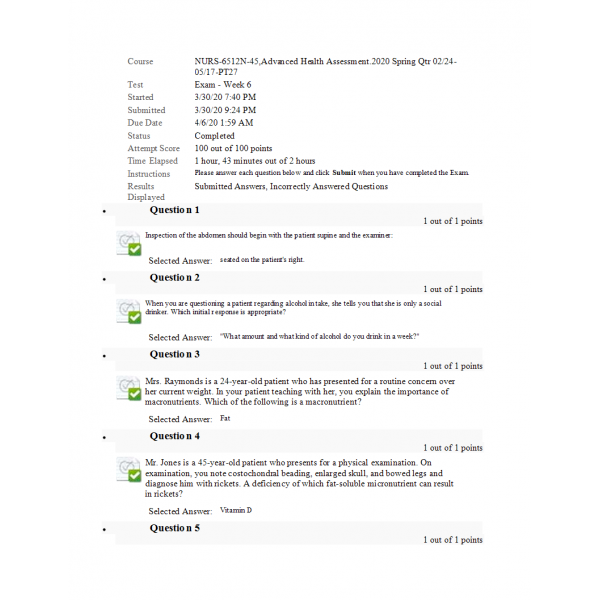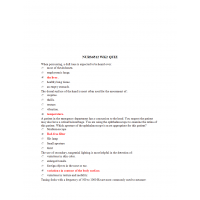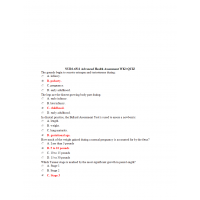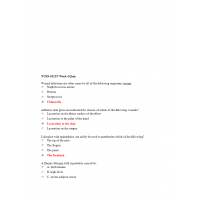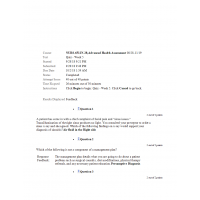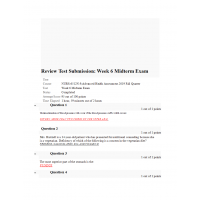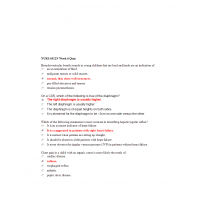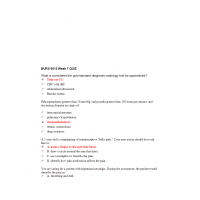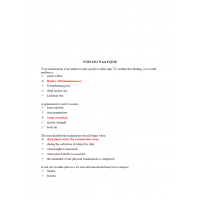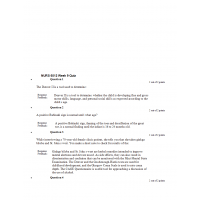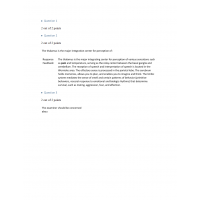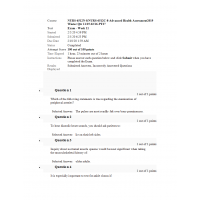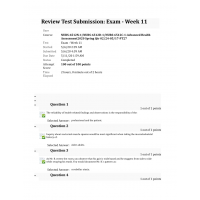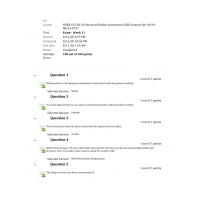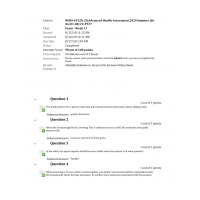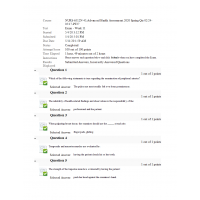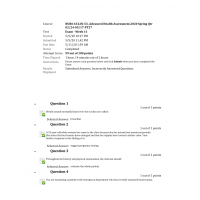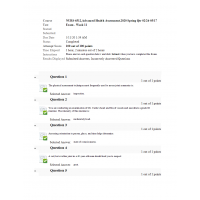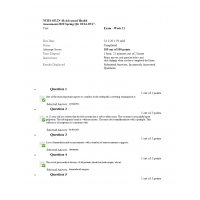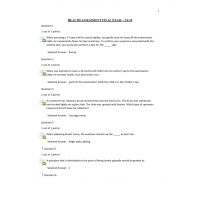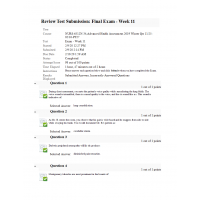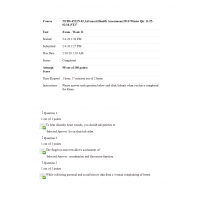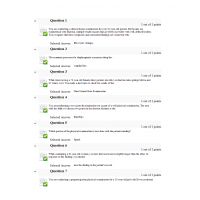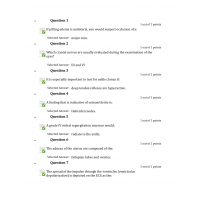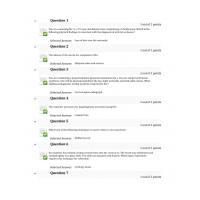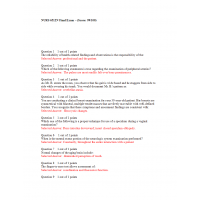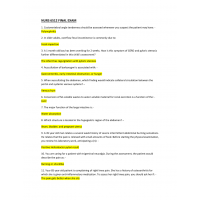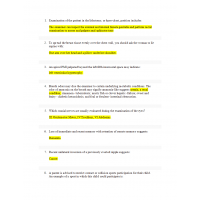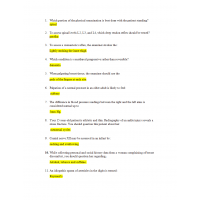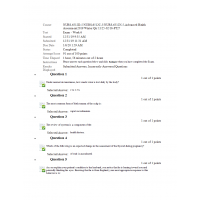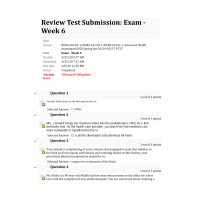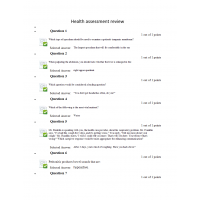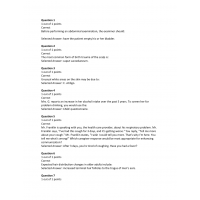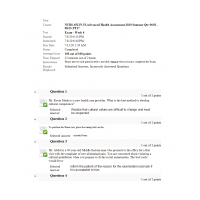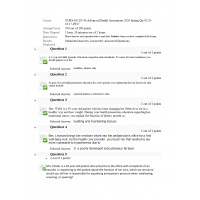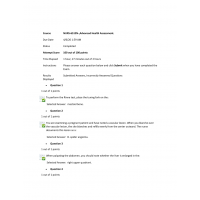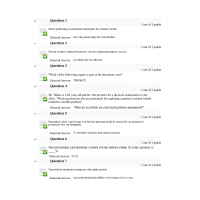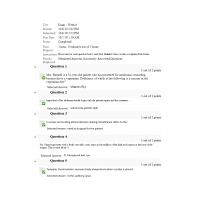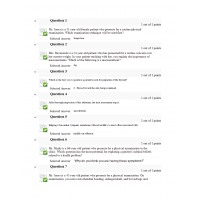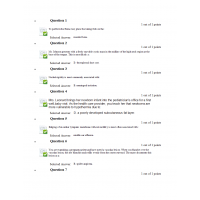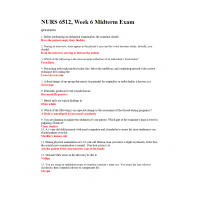NURS-6512N-45,Advanced Health Assessment Exam - Week 6
100 out of 100 points
1. Inspection of the abdomen should begin with the patient supine and the examiner:
2. When you are questioning a patient regarding alcohol intake, she tells you that she is only a social drinker. Which initial response is appropriate?
3. Mrs. Raymonds is a 24-year-old patient who has presented for a routine concern over her current weight. In your patient teaching with her, you explain the importance of macronutrients. Which of the following is a macronutrient?
4. Mr. Jones is a 45-year-old patient who presents for a physical examination. On examination, you note costochondral beading, enlarged skull, and bowed legs and diagnose him with rickets. A deficiency of which fat-soluble micronutrient can result in rickets?
5. To approximate vocal frequencies, which tuning fork should be used to assess hearing?
6. You are planning to palpate the abdomen of your patient. Which part of the examiner's hand is best for palpating vibration?
7. During percussion, a dull tone is expected to be heard over:
8. Tangential lighting is best used for inspecting skin:
9. You are palpating a patient's thyroid and find that its broadest dimension measures 4 cm. The right lobe is 25% larger than the left. These data would indicate:
10. Mr. Kevin Marks is a new health care provider. What is the best method to develop cultural competence?
11. Percussing at the right midclavicular line, below the umbilicus, and continuing upward is the correct technique for locating the:
12. The most superior part of the stomach is the:
13. Which part of the information contained in the patient's record may be used in court?
14. White, rounded, or oval ulcerations surrounded by a red halo and found on the oral mucosa are:
15. Which technique is most likely to result in the patient's understanding of questions?
16. The most common form of birth trauma of the scalp is:
17. Bulging of an amber tympanic membrane without mobility is most often associated with:
18. A college student comes to the student health center complaining of difficulty in concentrating during class and while studying. The diet that would contribute to this problem is one that consumes mostly:
19. Which question would be considered a leading question?
20. When palpating the abdomen, you should note whether the liver is enlarged in the:
21. George Michaels, a 22-year-old patient, tells the nurse that he is here today to "check his allergies." He has been having "green nasal discharge" for the last 72 hours. How would the nurse document his reason for seeking care?
22. Regardless of the origin, discharge is described by noting:
23. Expected hair distribution changes in older adults include:
24. Your patient presents with symptoms that lead you to suspect acute appendicitis. Which assessment finding is least likely to be associated with this condition early in its course?
25. To correctly document absent bowel sounds, one must listen continuously for:
26. Mrs. Britton is a 34-year-old patient who presents to the office with complaints of skin rashes. You have noted a 4' 3-cm, rough, elevated area of psoriasis. This is an example of a:
27. When examining the skull of a 4-month-old baby, you should normally find:
28. Pigmented, raised, warty lesions over the face and trunk should be assessed by an experienced practitioner who can distinguish:
29. Ms. Jones is a 31-year-old female patient who presents for a routine physical examination. Which examination technique will be used first?
30. Mr. Williams, age 25, has recovered recently from an upper and lower respiratory infection. He describes a long-standing nasal dripping. He is seeking treatment for a mild hearing loss that has not gone away. Information concerning his chronic postnasal drip should be documented within which section of his history?
31. You are collecting a history from an 11-year-old girl. Her mother is sitting next to her in the examination room. When collecting history from older children or adolescents, they should be:
32. During an interview, tears appear in the patient's eyes and his voice becomes shaky. Initially, you should:
33. The infant should be placed in which position to have his or her height or length measured?
34. Which of the following organs is part of the alimentary tract?
35. Sweat glands, hair, and nails are all formed from:
36. Cherry angiomas are a common finding in:
37. Which of the following is the most vital nutrient?
38. Mrs. Kinder is a 39-year-old patient who presents to the office with complaints of an earache. In explaining to the patient about the function of her ears, which ear structure would you tell her is responsible for equalizing atmospheric pressure when swallowing, sneezing, or yawning?
39. Which of the following formats would be used for visits that address problems not yet identified in the problem-oriented medical record (POMR)?
40. When assessing abdominal pain in a college-age woman, one must include:
41. Subjective and symptomatic data are:
42. During an interview, you have the impression that a patient may be considering suicide. Which action is essential?
43. A blood pressure cuff bladder should be long enough to:
44. Which is the best way to position a patient's neck for palpation of the thyroid?
45. Periods of silence during the interview can serve important purposes, such as:
46. A tool used to screen adolescents for alcoholism is the:
47. Peritonitis produces bowel sounds that are:
48. Mr. Black is a 44-year-old patient who presents to the clinic with complaints of neck pain that he thinks is from his job involving computer data entry. As the examiner, you are checking the range of motion in his neck and note the greatest degree of cervical mobility is at:
49. Penicillin is considered a
50. Your patient is complaining of acute, intense sharp epigastric pain that radiates to the back and left scapula with nausea and vomiting. Based on this history, your prioritized physical examination should be to:
51. Which of the following is an expected change in the assessment of the thyroid during pregnancy?
52. Mr. Walters, a 32-year-old patient, tells you that his ears are "stopped up." An objective assessment of this complaint is achieved by using the:
53. To perform the Rinne test, place the tuning fork on the:
54. Which of the following is an "ABCD" characteristic of malignant melanoma?
55. Ms. Otten is a 45-year-old patient who presents with a complaint of weight gain. Which medication is frequently associated with weight gain?
56. When communicating with older children and teenagers, you should be sensitive to their:
57. Tuning forks with a frequency of 500 to 1000 Hz are most commonly used to measure:
58. You are completing a general physical examination on Mr. Rock, a 39-year-old man with complaints of constipation. When examining a patient with tense abdominal musculature, a helpful technique is to have the patient:
59. A fixed image of any group that rejects its potential for originality or individuality is known as a(n):
60. Mrs. Grace is a 58-year-old patient who has a diagnosis of pernicious anemia. Which B vitamin is deficient in patients with pernicious anemia?
61. The attitudes of the health care professional:
62. Which of the following occurs when firm pressure is used to apply the stethoscope's bell end-piece to the skin?
63. Mrs. Berger is a 39-year-old woman who presents with a complaint of epigastric abdominal pain. You have completed the inspection of the abdomen. What is your next step in the assessment process?
64. After thorough inspection of the abdomen, the next assessment step is:
65. Your patient returns for a blood pressure check 2 weeks after a visit during which you performed a complete history and physical. This visit would be documented by creating a(n):
66. The recommended minimum daily protein requirement for the normal adult is ______.
67. A serous membrane that lines the abdominal cavity and forms a protective cover for many abdominal structures is the:
68. In examining the neck of a 34-year-old female patient, you note that the uppermost ridge of the tracheal cartilage is at the:
69. Mrs. Hartzell is a 34-year-old patient who has presented for nutritional counseling because she is a vegetarian. Deficiency of which of the following is a concern in the vegetarian diet?
70. Tympanic thermometers measure body temperature when a probe is placed:
71. Nasal symptoms that imply an allergic response include:
72. Differential diagnoses belong in the:
73. Mrs. Webb is a 38-year-old patient who has been changing her lifestyle to eat in a healthy way and lose weight. During your health promotion education regarding her nutritional status, you explain the function of dietary protein as:
74. When recording physical findings, which data are recorded first for all systems?
75. Mr. Abdul is a 40-year-old Middle Eastern man who presents to the office for a first visit with the complaint of new abdominal pain. You are concerned about violating a cultural prohibition when you prepare to do his rectal examination. The best tactic would be to:
76. Mrs. Leonard brings her newborn infant into the pediatrician's office for a first well-baby visit. As the health care provider, you teach her that newborns are more vulnerable to hypothermia due to:
77. A flat, nonpalpable lesion is described as a macule if the diameter is:
78. Mr. Mills is a 55-year-old patient who presents to the office for an initial visit for health promotion. A survey of mobility and activities of daily living (ADLs) is part of a(an):
79. Spasmodic muscular contractions of the head, face, or neck are called:
80. Mr. Sanchez is a 45-year-old gentleman who has presented to the office for a physical examination to establish a new primary care health care provider. Which of the following describes a physical, not a cultural, differentiator?
81. You have just completed a skin assessment on Mr. Baker. During your assessment, you have transilluminated a skin lesion. During the physical examination, you know that skin lesions are transilluminated to distinguish:
82. Mr. Akins is a 78-year-old patient who presents to the clinic with complaints of hearing loss. Which of the following are changes in hearing that occur in the elderly? Select all that apply.
83. Which technique is most likely to result in the patient's understanding of questions?
84. In counseling a client regarding nutrition education, you explain that linoleic acid, a major fatty acid, is thought to be essential for:
85. Ms. Davis is a 27-year-old patient with a BMI of 33. Based on her BMI, your diagnosis would be:
86. Recommended carbohydrate content of total dietary intake (% total calories) is ____%.
87. When assessing abdominal pain in a college-age woman, one must include:
88. Which statement is true regarding the relationship of physical characteristics and culture?
89. Small, minute bruises are called:
90. Mrs. Britton brings her 16-year-old son in with a complaint that he is not developing correctly into adolescence. Which structures disproportionately enlarge in the male during adolescence?
91. You are examining a pregnant patient and have noted a vascular lesion. When you blanche over the vascular lesion, the site blanches and refills evenly from the center outward. The nurse documents this lesion as a:
92. The position on a clock, topographic notations, and anatomic landmarks:
93. The review of systems is a component of the:
94. Before performing an abdominal examination, the examiner should:
95. Ms. G. is being seen for her routine physical examination. She is a college graduate and president of a research firm. Although her exact salary is unknown, she has adequate health insurance. Most of the above information is part of Ms. G.'s _____ history.
96. A 17-year-old girl presents to the clinic for a sports physical. Physical examination findings reveal bradycardia, multiple erosions of tooth enamel, and scars on her knuckles. She appears healthy otherwise. You should ask her if she:
97. Unusual white areas on the skin may be due to:
98. When are open-ended questions generally most useful?
99. Mr. Mathews is a 47-year-old patient who presents for a routine physical examination. On examination, you have noted a bruit heard over the thyroid. This is suggestive of:
100. Auscultation should be carried out last, except when examining the:
| Institution & Term/Date | |
| Term/Date | Walden University |
NURS 6512N Midterm Exam 3 (100 out of 100)
- Product Code: 2020
- Availability: In Stock
-
$30.00
Related Products
Tags: NURS 6512N

